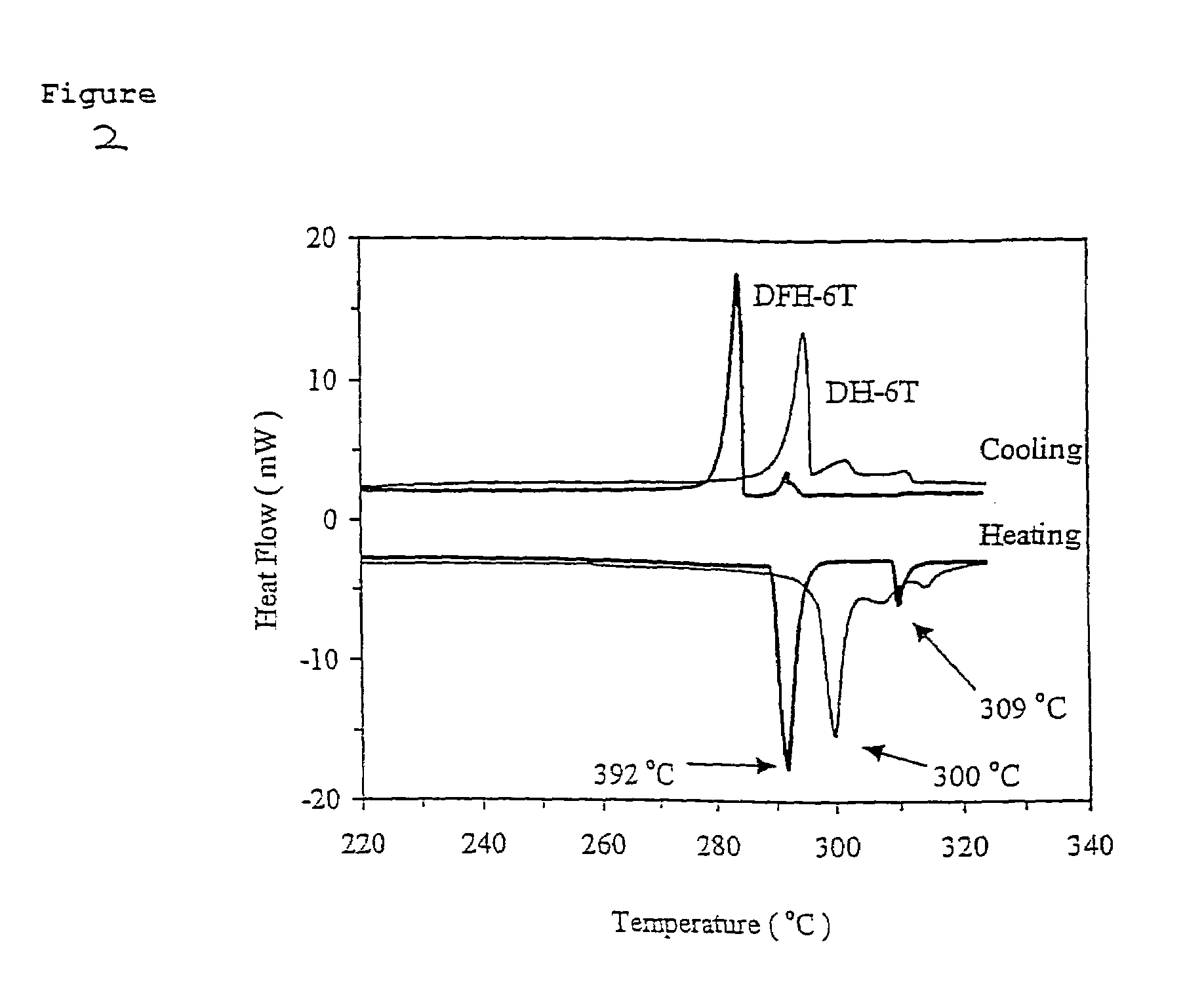n-Type thiophene semiconductors
a technology of thiophene and semiconductors, applied in the direction of non-metal conductors, conductors, organic conductors, etc., can solve problems such as a large number
- Summary
- Abstract
- Description
- Claims
- Application Information
AI Technical Summary
Benefits of technology
Problems solved by technology
Method used
Image
Examples
example 1
[0058]DFH-6T was synthesized in high yield via Pd0-catalyzed Stille coupling of 5-bromo-5′-perfluorohexyl-dithiophene (6) with 5,5′-di(tributyl-stannyl)dithiophene (FIG. 1). This route affords DFH-6T (1) in high purity and yield (˜95%) after multiple gradient sublimation. Note that although monosubstituted perfluoroalkyl thiophene oligomers up to three units have been reported, synthetic yields were typically ˜10%. For example, 3′-perfluorohexylterthiophene was isolated in ˜11% yield.
example 2
[0059]The comparative thermal properties of DFH-6T and DH-6T were investigated by differential scanning calorimetry (DSC) and thermogravimetric analysis (TGA). In the DSC, both compounds exhibit at least one transition (FIG. 2). Compound DH-6T exhibits a distinct crystal-to-liquid crystal (LC) transition at 292° C. and a LC-to-isotropic transition at 309° C., while the literature shows crystal-to-LC transition of 2 (300° C.) falls just below the melting point, 308–313° C. These mesophase formation events are not surprising in view of the molecular architectures. However, the most interesting feature is that the two systems exhibit such similar thermal behavior and almost identical melting points, suggesting that strong DH-6T π-π interactions are preserved upon fluorine substitution.
example 3
[0060]In contrast, the α,ω-fluorocarbon chains have a dramatic effect on the volatility of DFH-6T as shown by TGA (FIG. 3A). The monotonic % weight loss vs. T demonstrates smooth, clean, quantitative sublimation well below the melting point with negligible residue. In contrast, DH-6T exhibits significant volatility only above the melting point, with the TGA data revealing inflections at ˜298 and ˜306° C., suggesting decomposition processes. In addition, a significant decomposition-related residue (˜6%) is observed at 320° C. The enhanced volatility of DFH-6T (vs. DH-6T) is further demonstrated by isothermal TGA (FIG. 3B) where DH-6T sublimation at the lowest possible temperature leaves ˜8% decomposition residue.
PUM
| Property | Measurement | Unit |
|---|---|---|
| thick | aaaaa | aaaaa |
| temperature | aaaaa | aaaaa |
| melting point | aaaaa | aaaaa |
Abstract
Description
Claims
Application Information
 Login to View More
Login to View More - R&D
- Intellectual Property
- Life Sciences
- Materials
- Tech Scout
- Unparalleled Data Quality
- Higher Quality Content
- 60% Fewer Hallucinations
Browse by: Latest US Patents, China's latest patents, Technical Efficacy Thesaurus, Application Domain, Technology Topic, Popular Technical Reports.
© 2025 PatSnap. All rights reserved.Legal|Privacy policy|Modern Slavery Act Transparency Statement|Sitemap|About US| Contact US: help@patsnap.com



